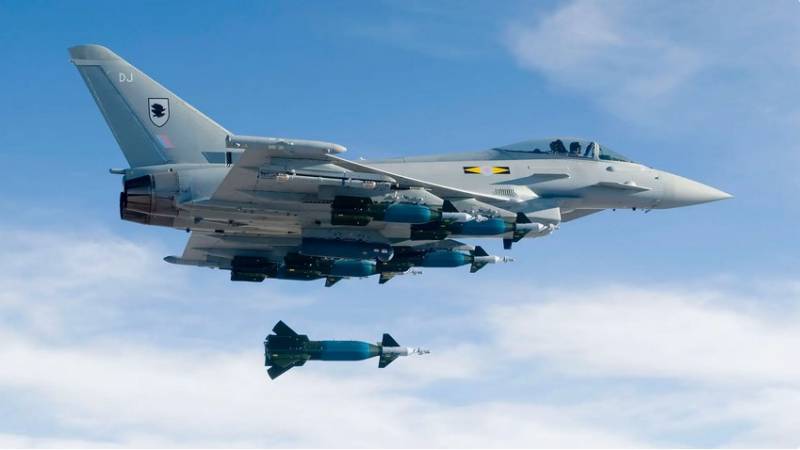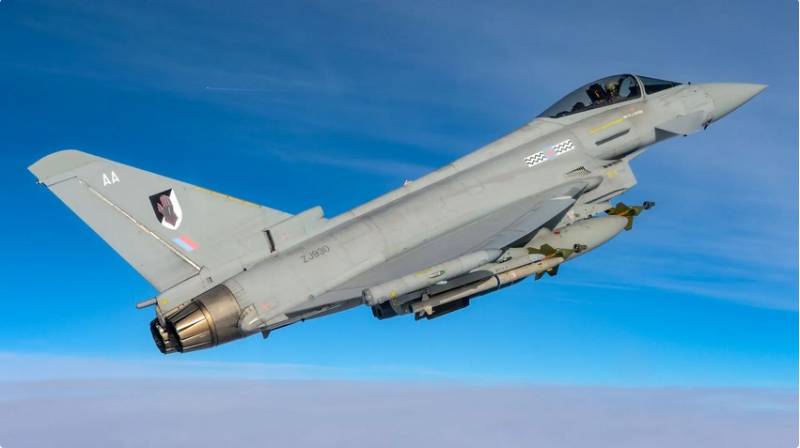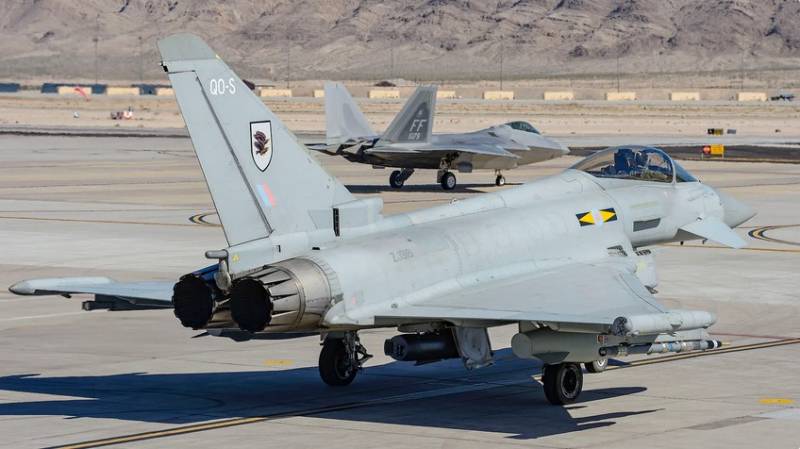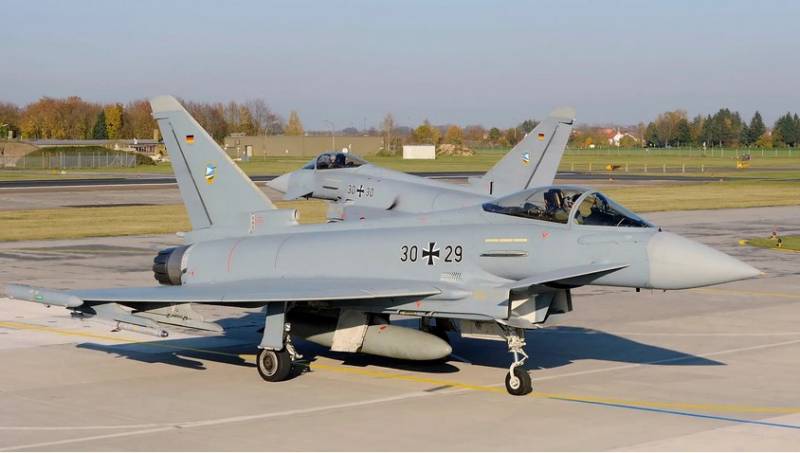And will we be afraid of the mighty Eurofighter?

Well, after the F-16 and the Mirage 2000, it was the turn of the next aircraft. Fighter RAF Tranche1 Eurofighter "Typhoon" may be the subject of consideration in the British Parliament. So announced British Prime Minister Rishi Sunak, who said "nothing has been cleared off the table" in response to an impassioned appeal by Ukrainian President Volodymyr Zelensky during a high-profile visit to the United Kingdom on 8 February.
Zelensky continues his begging voyage across Europe, knocking out wherever and whatever he can. Great Britain was no exception, and in this country the Ukrainian president was especially eloquent. In general, as they say in our country - "nanyl".
Apparently, there was something in conversations that were not available to the public, as rumors spread that the UK would provide Ukraine with some of its old Eurofighter Typhoon aircraft. Moreover, the rumors began to receive not only indirect, but very direct confirmation. And "on the table" there may well be documents, according to which the UK will send its aero-barriers to Ukraine.
The British prime minister has spoken extensively on behalf of the country about supporting Ukraine's air force needs, saying the UK will begin training Ukrainian pilots to fly on "standard NATO platforms" this spring.
"When it comes to fighter combat aviationof course they (standard NATO platforms) are part of the conversation"- Sunak.
The Prime Minister's Office confirmed that British Defense Secretary Ben Wallace will be considering what aircraft the UK could potentially offer to Ukraine, stressing that this would be a "long-term solution".
But how realistic would it be to get British aircraft into Ukrainian hands? And which ones, because our air defense and aerospace forces may have to deal with them.
The Royal Air Force (RAF) currently operates two main types of fighter aircraft, the Eurofighter "Typhoon" and the Lockheed Martin F-35B "Lightning". It is clear that the second Ukraine does not shine under any circumstances, but the first - why not?

All the same practice that was discussed in the article about Mirages. Give away your old one and order new equipment instead. So "Typhoon" can easily change color and emblem. And therefore it makes sense to look at what the Air Force of the Armed Forces of Ukraine can get at its disposal and how this may affect the Ukrainian theater of operations.
The Eurofighter was built by a consortium of European companies in the UK, Germany, Italy and Spain, and all of these countries jointly built aircraft for their air force. It is possible that some kind of general agreement will be required for the transfer of these aircraft to Ukraine. Or, alternatively, the countries-right holders can decide jointly on cooperation, sharing the responsibility for the transfer. This could facilitate both the training of Ukrainian pilots and facilitate the supply of aircraft of a similar standard, but from different sources. This could reduce both the load on pilot training centers and the technical services of the air fleets.
The Royal Air Force already has many well-described problems with the training of British military pilots, and Ukrainian ones also need to be taught. A joint plan to provide Typhoons to Ukraine could help circumvent these problems in the UK, using existing German and Italian training centres. Italy is remarkable in that it has a very good training system, which is already used by many air forces of other countries, who train their pilots within the walls of the International Flight Training School (IFTS) in Sardinia.
What is Typhoon anyway?

The plane, which according to Prime Minister Sunak, can be delivered to Ukraine, has three main models. The oldest and least capable are known as "Series 1", which the RAF received during 2003. These fighters were produced as pure air defense fighters. Armament consisted of MBDA Advanced Short Range Air-to-Air Missile (ASRAAM) and Raytheon AIM-120 Advanced Medium-Range Air-to-Air Missile (AMRAAM) air-to-air missiles, as well as a cannon. A good set, and such aircraft could well compete even with the F-16. Such RAF aircraft received 53 units.
Further, the RAF received 67 upgraded "Series 2" aircraft and 40 "Series 3" aircraft, for a total of about 160 aircraft. These upgraded variants feature improved avionics and a redesigned nose that allows for future upgrades to Active Electronically Scanned Array Radar (AESA or AFAR).
The second and third series were exactly what the Royal Air Force demanded from manufacturers: a truly versatile multi-role fighter with great potential for further upgrades. It was these aircraft that were supposed to replace the very good, but thoroughly outdated Tornadoes, according to the plan.
Initially created as air defense fighters, Typhoons of the 2nd and 3rd series got the opportunity to work on ground targets. This was the main modernization path carried out by the manufacturing countries and included the Israeli-made Rafael Litening III guidance system, as well as the ability to equip aircraft with the Raytheon Paveway IV guided bomb for British aviation and GBU-48 (EGBU-16) Enhanced Paveway II (EPW2) for other countries.
Around 2010, the paths of modernization of the British Air Force and the European diverged. The command of the Royal Air Force preferred to strengthen the bombing and assault capabilities of the Typhoons of the first series, until the aircraft of the next series, in which strike capabilities would be laid down from the very beginning, came up.

On 20 March 2011, the Royal Air Force deployed Typhoons to Gioia del Colle, Italy to support the enforcement of a no-fly zone (NFZ) over Libya as part of an ongoing special operation. On April 12, one Typhoon, acting in conjunction with the Tornado, dropped two EPW2 bombs on two tank, marking the combat debut as an attack aircraft.
The second and third series of the Typhoon were modernized, the MBDA Storm Shadow cruise missile, the MBDA Meteor long-range air-to-air missile (BVRAAM) and the Brimstone homing missile were put into service.
In 2010, it was decided to withdraw the aircraft of the first series from the Air Force and dispose of them by 2019. This happened with the first 16 aircraft, the rest decided to leave and use them as air defense fighters, arming them with AIM-120 AMRAAM missiles, and not with Meteors, like aircraft of series 2 and 3.
Technically, the British aircraft manufacturer BAE Systems sees no problem in upgrading the aircraft of the first series to the level of the second and even third series. Such an upgrade could bring the Typhoons of the first series into the ranks of modern RAF aircraft, but does it make sense, especially in light of plans to acquire the F-35?
Meanwhile, in the European Air Force, along with the British, there are about 150 aircraft of the first series. The Eurofighter consortium built 33 aircraft for Germany, 28 for Italy, 19 for Spain and 53 for the UK, 15 for Austria. The UK plans to withdraw its aircraft from this batch from the Air Force, Germany also plans to abandon its first-series fighters. However, unlike the RAF, the German Luftwaffe are replacing their first series 38 fighters with new "Series 4" aircraft. Italy is also seeking to replace its earliest Typhoons with newer designs, and it is possible that Austria has its own plans for obsolete aircraft. Spain has chosen to purchase new Series 4 fighters, and has also developed its own upgrades for its 19 Series 1s, adding IRIS-T and AIM-120C-7 air-to-air missiles, a Litening III sighting module and a high-precision bomb GBU-48.
It turns out that European countries have something to offer Kyiv in terms of aircraft. It is difficult to assess their technical condition, but out of 148 aircraft, at least half can definitely be considered combat-ready. The UK, Germany, Italy and even Austria potentially have aircraft that could be sent to Ukraine.

At present, the Royal Air Force is actually ready to write off their Typhoons. It is planned to purchase the Czech L-159 Draken as training aircraft, and provide the combat load to the Lightnings.
It turns out that a total of 30 "Series 1" aircraft that could potentially be provided by the UK to Ukraine correspond very closely to the recent request of Colonel Yuriy Ignat, the chief press officer of the Ukrainian Air Force Command, for two squadrons of 12 fighter aircraft plus reserves. According to Ignat, such a force would be sufficient, at least initially, to help improve the situation in the sky against Russian aircraft.
Previous attempts by Britain and Italy to sell unwanted "Series 1" aircraft were unsuccessful. Other Eastern European countries such as Bulgaria considered the Eurofighter but ultimately decided against it. So now we are talking about finding the right solution for Ukraine.
What are the strengths and weaknesses of Typhoon?

The most painful question is whether Ukraine will be able to maintain the expensive Typhoon. This is not only expensive, but also a very difficult aircraft to operate in technical terms. It is very doubtful that the Typhoon is suitable for operations from field airfields - Typhoons were usually based on the main operating bases, from where they came from. In addition, low-lying air intakes constantly raise concerns about the ingress of stones and other foreign objects.
In addition, Typhoon needs a serious support service for its intelligent electronic warfare and avionics system. Yes, the issue of runway condition may be less of a concern now with recent the news that Ukraine is already preparing airfields across the country in anticipation of the supply of Western fighters.
By the way, a variant with joint training of pilots is possible, as was implemented in the agreement with Qatar. They just took and created a joint British-Qatari squadron No. 12, on two-seater Typhoons, where they began to train pilots of the Qatari Air Force and train their own. Everything works fine.
Let's move on to the most important - combat capabilities.
If the stripes in Ukraine are put in order, the pilots will be trained in the UK, all that remains is to put them in the cockpit and send them to perform combat missions.
And here there will be problems of a certain nature. "Typhoon" of any series (but the first - especially) is, as it were, not very well suited for operations at low and ultra-low altitudes. The aircraft is extremely agile and powered by the same Eurojet EJ200 engines as later variants. The powerful Captor-M mechanically scanned radar is considered one of the most impressive non-AFAR radars in the world, and when combined with the AIM-120 AMRAAM, this represents a decent potential that is very much in line with the combination of missiles and long-range radars that Ukraine is so keen on.
But - the fighter asks for heights. It can be said, of course, and some foreign experts say that the Ukrainian Air Force uses outdated tactics of operating at altitudes below 500-600 meters, which is unacceptable for the Typhoon, whose engine starts to eat fuel at such an altitude, as if in itself. But what to do, either save fuel and save engine life, or get a “hello” from the Russian air defense system. The choice is very poor.
It seems that the Typhoon has a very good self-defense complex, but this has yet to be verified. If a British fighter jet can "blow off" Russian missiles, yes, it is possible that air warfare will move to high altitudes. But if it turns out differently, there is a possibility that the Typhoon will turn out, to put it mildly, incapable of any real action.
And, let's just think about two things about the Typhoon. The first thing is called S-300, the second - Buk-M3. And let's try to give ourselves, without deceiving, the answer to the question: "Can Typhoon successfully operate where these anti-aircraft missile systems operate?" And we understand that it is unlikely.

This means that you will have to forget about the heights at which the Typhoon feels comfortable. But at low altitudes, where not only is the Typhoon not really a typhoon, there is also someone to moderate its ardor.
However, in addition to the threat from Russian air defense systems and aircraft, there is another threat: the fact that the RAF, which will make such a generous gift, is one thing, but the support of Eurofighter is another. And how will it be with technical support from a manufacturer scattered throughout Europe - this is a very sore point.
Yes, spare parts. Just spare parts for old Typhoons. Provision of older spare parts, parts for older types of weapons and so on is another difficult point in stories with Typhoons.
And another awkward moment. Eurofighter produces aircraft for several countries, but only then the countries themselves “sharpen” the aircraft to suit their needs.
I translate: The British version of the Typhoon is equipped with a certain amount of secret software and hardware that allows the aircraft to be reprogrammed to counter evolving threats, which, of course, is currently not allowed for export. Although, it is likely that some of this software can be completely disabled in order to provide permission for the transfer of aircraft to Ukraine.
Of course, not everything is as smooth as the president-beggar would like. Speaking at a conference the day after Mr Zelensky visited London, UK Defense Secretary Ben Wallace said it would be more realistic and more productive to see the UK providing Ukraine with aircraft in the long term to keep it safe after the war with Russia ends.
That is, it seems that the conversation about Typhoons is going on, but who said that this will happen when the Ukrainian president wants it? But the topic is not hushed up, the topic is clearly developing.
What else can be said about the combat capabilities of the Typhoon?

This is a machine of the same class with the F-16. But "Typhoon" is "Falcon" at maximum speed. He is faster, faster climbs to a greater height than the Falcon. Two motors provide the best speed performance. The amount of combat load is approximately the same. At the end of the article, you can follow the links to articles about the Mirage 2000 and F-16 and brush up on the characteristics.
In general, the European fighter does not pose a particular danger to Russian Su-30 and Su-35 aircraft. On the contrary, it is Russian fighters that pose a danger, which is associated with a large load of R-37M long-range air-to-air missiles (4 pcs), the ability to launch missiles at supersonic speeds, super-maneuverability and very worthy capabilities of electronic systems.
And, the main disadvantage is just the huge cost of Typhoons. $120 million is just the base package. Of course, a gift is a gift and it’s not customary to talk about the price here, but nevertheless, it’s one thing to drop an F-16 worth $45-50 million per unit on the ground, and another thing is a Eurofighter, which costs two and a half times more expensive.
Typhoon may not be the solution here and now, but it could be part of an aid package aimed at preparing the Ukrainian Air Force of the future. Then, if there is Ukraine.
On the other hand, even if the Typhoons are never delivered to Ukraine, the discussion around them - and similar thrust in France (with Mirages), the Netherlands and Poland (with F-16s) - may well help open the floodgates and lead to that NATO-standard aircraft, albeit others, not British, will finally reach the Ukrainian Air Force.
This has already happened in the case of main battle tanks, when the UK proposal for the "Challenger 2" was accompanied by provocative nudges from other allies to send their tanks.
It would be unwise to bet that fighter jets will not be next in line for Ukraine. This may happen in the not too distant future once the pilots for these aircraft are trained.
Another question is how much all this can help Ukraine in gaining air superiority.
And the question posed in the title: should the Russian Aerospace Forces be afraid of the Eurofighter in the skies of Ukraine?

Nothing more than an F-16 or a Mirage 2000. This pair, perhaps, will be even more dangerous, because although they do not have such high-altitude characteristics and are inferior in speed, they are more maneuverable and feel very good at low altitudes.
As long as our aircraft have an advantage over European and American fighters, as long as the Europeans set delivery dates, there seems to be nothing to worry about. And how it will develop further - time will tell.
But perhaps we will not be afraid of the powerful Typhoon. Even if Zelensky really asks for it.
Information